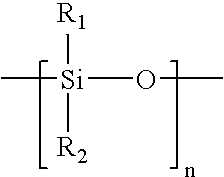Prepolymers with dangling polysiloxane-containing polymer chains
- Summary
- Abstract
- Description
- Claims
- Application Information
AI Technical Summary
Benefits of technology
Problems solved by technology
Method used
Image
Examples
example 1
[0146]Oxygen permeability measurements. The oxygen permeability of a lens and oxygen transmissibility of a lens material is determined according to a technique similar to the one described in U.S. Pat. No. 5,760,100 and in an article by Winterton et al., (The Cornea: Transactions of the World Congress on the Cornea 111, H.D. Cavanagh Ed., Raven Press: New York 1988, pp 273-280), both of which are herein incorporated by reference in their entireties. Oxygen fluxes (J) are measured at 34° C. in a wet cell (i.e., gas streams are maintained at about 100% relative humidity) using a Dk1000 instrument (available from Applied Design and Development Co., Norcross, Ga.), or similar analytical instrument. An air stream, having a known percentage of oxygen (e.g., 21%), is passed across one side of the lens at a rate of about 10 to 20 cm3 / min., while a nitrogen stream is passed on the opposite side of the lens at a rate of about 10 to 20 cm3 / min. A sample is equilibrated in a test media (i.e., s...
example 2
Preparation of Initiator Solution
[0152]Initiator solutions are prepared by dissolving a desired amount of an initiator in t-amyl alcohol as shown in Table 1. The resulting solution is stirred and degassed at room temperature 2 times for 5 minutes each below 50 mbar.
TABLE 1ExampleReactant2a (grams)2b (grams)AIBN0.0590.059t-amyl alcohol11.4011.44
Preparation of Reactor Solution
[0153]Various reactants shown in Table 2 are weighed into a 500 mL reactor equipped with vacuum and nitrogen. The resulting solution is stirred and chilled to 4° C. and then degassed 10 times for 5 minutes each at less than 1 mbar, using nitrogen to back-fill.
TABLE 2ExampleReactant2a (grams)2b (grams)PDMS-11500 diacrylamide11.508.05PDMS-5000 monomethacrylate “MCR-M17”*NA3.45Aminopropyl methacrylate hydrochloride1.331.33Acrylic Acid0.040.04Hydroxyethyl acrylate5.305.30N,N-dimethylacrylamide7.967.96t-amyl alcohol320.42320.35*from Gelest
Preparation of Prepolymer
[0154]A reactor solution temperature prepared above is ...
PUM
| Property | Measurement | Unit |
|---|---|---|
| Length | aaaaa | aaaaa |
| Fraction | aaaaa | aaaaa |
| Fraction | aaaaa | aaaaa |
Abstract
Description
Claims
Application Information
 Login to View More
Login to View More - R&D
- Intellectual Property
- Life Sciences
- Materials
- Tech Scout
- Unparalleled Data Quality
- Higher Quality Content
- 60% Fewer Hallucinations
Browse by: Latest US Patents, China's latest patents, Technical Efficacy Thesaurus, Application Domain, Technology Topic, Popular Technical Reports.
© 2025 PatSnap. All rights reserved.Legal|Privacy policy|Modern Slavery Act Transparency Statement|Sitemap|About US| Contact US: help@patsnap.com



